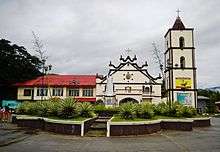Santa Catalina de Siena Church (Bambang)
The Santa Catalina de Siena Parish Church, commonly referred to as Bambang Church, is an 18th-century, Baroque church located at Brgy. Buag, Bambang, Nueva Vizcaya, Philippines. The parish church, dedicated to Saint Catherine of Siena, is under the jurisdiction of the Roman Catholic Diocese of Bayombong.
| Bambang Church | |
|---|---|
| Santa Catalina de Siena Parish Church | |
 Façade of the Santa Catalina Church in Bambang, Nueva Vizcaya | |
.svg.png) Bambang Church Republic of the Philippines | |
| 16°23′06″N 121°06′17″E | |
| Location | Nueva Vizcaya |
| Country | Philippines |
| Denomination | Roman Catholic |
| History | |
| Status | Parish church |
| Founded | 1747 |
| Dedication | St. Catherine of Siena |
| Architecture | |
| Functional status | Active |
| Architectural type | Church building |
| Style | Baroque |
| Groundbreaking | 1772 |
| Completed | 1791 |
| Specifications | |
| Materials | Brick, Sand, Stone, Gravel, Cement, Steel, Concrete |
| Administration | |
| Archdiocese | Tuguegarao |
| Diocese | Bayombong |
| Clergy | |
| Archbishop | Most Rev. Ricardo L. Baccay, D.D. |
| Bishop(s) | Most Rev. Jose Elmer I. Mangalinao, D.D. |
Parish history
Christianity had its origins in Bambang when the Dominicans, led by Father Tomas Gutierrez, established the mission called Ytuy in 1609 to convert and serve the local tribe called Isinay. The present-day towns of Bambang, Bayombong, Aritao, and Kayapa comprised the said mission.[1] Bambang, then called San Bernardo, was officially created as a town in July 5, 1747. The Dominicans established their convent in Bambang in 1751 with Father Cristobal Rodriguez as its first vicar. Years later, the construction of the present church started. In 1772, the construction of the church commenced under Father Domingo Caro, OP. The church was completed before the turn of the century, in 1791. The remains of a certain Rosa de Santa Maria is recorded to have been interred in the church, under one of the side altarpieces dedicated to Our Lady of the Most Holy Rosary. Rosa de Santa Maria, an Igorot woman, is one of the two native Filipina "flowers of sanctity".[2]
Architecture
The church façade has been described as "nearly identical" to the façade of the Dupax del Sur Church, save for a few differences with regards to its details such as the absence of the blind windows on the first level, a slightly steeper pediment, and the presence of clay insets adorning oculus on the third level. A concrete canopy covering the main portal is a later addition into the structure. The four level bell tower is also very similar to that of the Dupax del Sur Church except for the plainer, plastered look and more pronounced cornices marking the boundaries of each level. Clay insets bearing the years 1775 and 1779 suggests the dates when the belfry level was completed.[1][2]
References
- Galende, OSA, Pedro (2007). Philippine Church Facades (First ed.). Manila, Philippines: San Agustin Museum. p. 111. ISBN 9789710724338.
- Hornedo, Florentino H. (2002). On The Trail of Dominican Engineers, Artists & Saints in the Cagayan Valley & Batanes (First ed.). Manila, Philippines: University of Santo Tomas Publishing House. p. 31. ISBN 9715061923.
External links
![]()